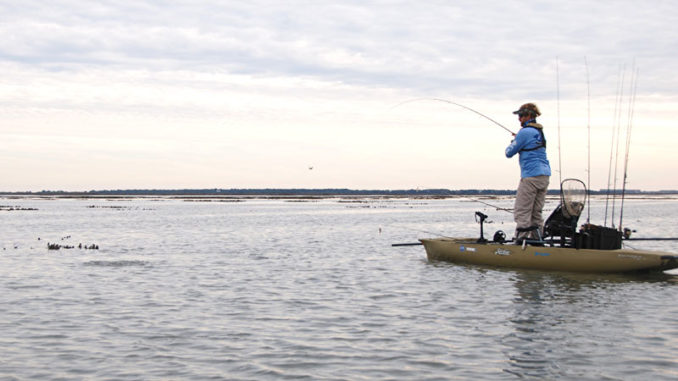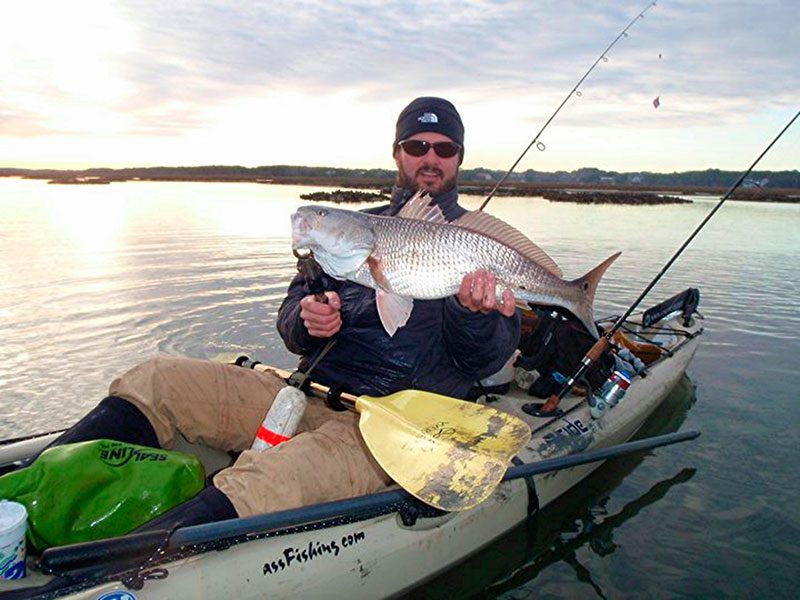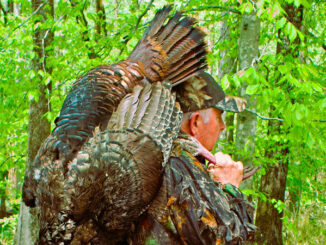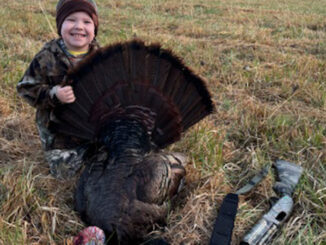
Nothing speaks of cold water inshore fishing more profoundly than sneaking up on a tightly packed pod of redfish and attempting to pick them off one by one.
Until they mature and head out into the ocean, most redfish rarely range more than ½ mile throughout their juvenile life. That means those same places where you find redfish in the spring, summer, and fall will be the same places you’ll find them in the winter.
During winter forays, redfish don’t range into deep water holes, but spend more time in shallower water, and for good reason. First, all the bait is gone and dolphins that normally feed on mullet or menhaden are now feeding on redfish. Second, a dark, shallow muddy bottom will be warmer than the surrounding area.
Kayak anglers who can locate and access the most remote reaches of shallow water – too shallow for heavier boats to pass – have a distinct advantage.
Winter tides in the Carolinas tend not to be as wide-ranging as summer tides. So a good bet is to look for mid-tide flats to hold more fish, especially those areas having oyster mounds or sandbars between them and deeper water. With hard ground between you and deeper water, once you’ve located a school of fish, you should have them to yourself.
Keep it slow
Lures that have a lot of action without having to move it that fast is a good bet. The use of scented baits or at least applying some add-on scent often plays a big part in how redfish find your bait.
Mudflats in the winter are generally devoid of active life. So anything that moves naturally along the bottom tends to get noticed when blind casting for individual redfish. Fast twitching a jerkbait or topwater lure works well in warmer weather but will tend to spook already nervous winter fish.
Unless spooked, redfish schools may not range very far in colder water. But they’ll show a distinctive movement that can be determined by observant kayak anglers who watch and wait for the right time to present a bait. If the movement of the school, which can number from 20, 30 to even 100 fish is too close and moving closer, allow the pod to pass by and then cast ahead of the fish and let them work to it or slowly move it back into the fish, being careful not to let the bait or even your line fall across the fish.
Best Bets
NORTH CAROLINA
WHAT — Redfish
WHERE — Cape Lookout area, shallow bays and marshes behind Beaufort and Morehead City
HOW — Most available bait will be small glass minnows and crabs, mostly found around shallow oyster rakes and expansive flats. Pole up and make decisive casts with like-sized bait offerings. Fly fishing is good when the wind allows.
LAUNCH — www.nps.gov/calo/planyourvisit/boat-ramps.htm
INSIDER TIP — Redfish are lethargic first thing, becoming more active as the sun heats the mud flats. Mid-day is often more productive than first light.
SOUTH CAROLINA
WHAT — Redfish
WHERE — Hilton Head area
HOW — Redfish are schooled up tight, holding in shallow water. Cast 1/4-ounce jigheads with a soft plastic shrimp or minnow in path of oncoming schools.
LAUNCH — www.hiltonhead.com/7-public-boat-landings-to-get-you-on-the-water/
INSIDER TIP — Winter conditions often cause murky water, so fish with scented or scent-enhanced baits, or try soaking mud minnows or cut crab in murky water haunts.
Preparation is key
Winter weather is a deterrent to many anglers regardless of the craft used simply because of the cold temperatures. That exposure is compounded when fishing from a paddle craft because of the close proximity to the water.

Dressing for a winter kayak fishing event is not unlike any other outdoor sport, combining layers of clothing that can be added or subtracted as the day wears on. It’s always better to use several thinner layers than one or two thicker layers.
Dressing for success means wearing both cold weather and water repellant clothing while avoiding cotton garments. Dressing in layers that allow movement is tantamount. It’s almost impossible not to get wet when fishing from a kayak, so dress with the understanding that you’re going to get wet to some degree.
Fortunately, mid-winter fishing action doesn’t tend to heat up until the sun is well above the horizon. This allows the kayak angler to get a late start and not miss any of the action. What tends to catch many anglers off guard is the shortness of the day, and the realization that a long paddle back to the take-out point may occur at or after sunset if you’re not paying attention to time. Cold, wet, and tired after dark is not the most desirable experience for a kayak angler.
Finally, plan on packing along emergency gear such as spare clothing, a towel, and emergency heating system in case you find yourself submerged in the water during the trip. Pack these items in a dry-storage bag so they’ll survive should the kayak turn over.





Be the first to comment